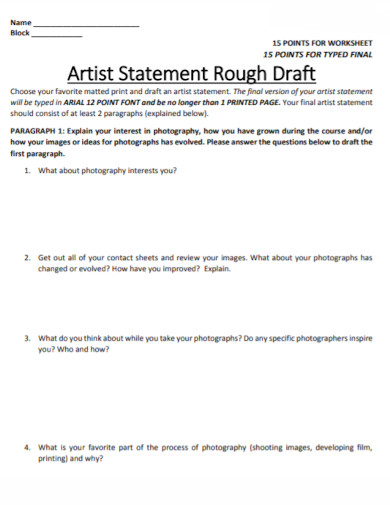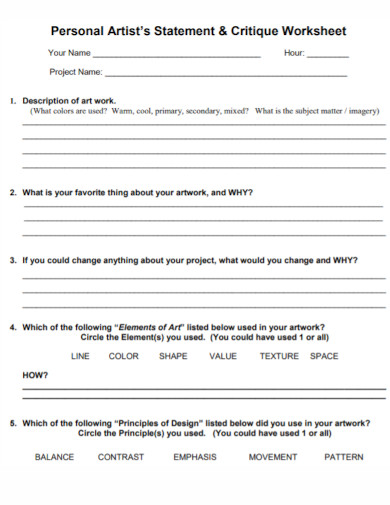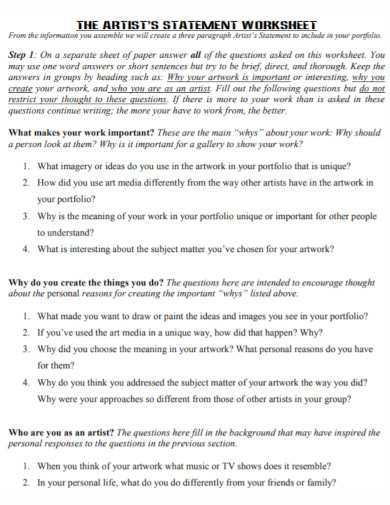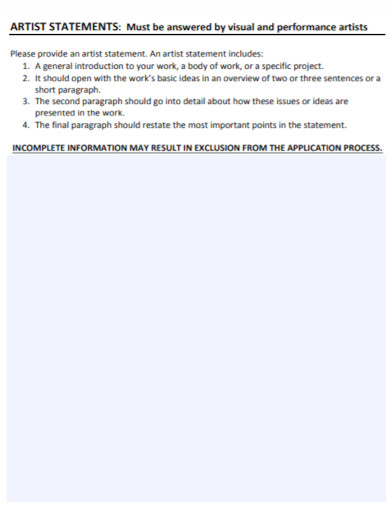When people create art, the five senses are not the only thing at play. It also involves planning, analyzing, and visualizing the artwork they want to produce. They say that for artists, the reward is not only the finished product but also the process. To get a grasp of their creative experience, compose and let them answer an artist statement worksheet.
[bb_toc content=”][/bb_toc]
10+ Artist Statement Worksheet Examples
1. Artist Statement Worksheet Template
2. Basic Artist Statement Worksheet
3. Printable Artist Statement Worksheet
4. Formal Artist Statement Worksheet
5. Artist History Statement Worksheet
6. Draft Artist Statement Worksheet
7. Professional Artist Statement Worksheet
8. Artist Statement Worksheet in PDF
9. General Artist Statement Worksheet
10. University Artist Statement Worksheet
11. Artist Statement Application Worksheet
What Is an Artist Statement Worksheet?
An artist statement worksheet is a document that is consists of questions that aim to make the artist share and communicate the process incorporated in producing the art. In addition, this type of evaluation worksheet also includes items that ask the artist about their inspiration and reasoning for generating a particular kind of art.
How to Devise an Inquisitive Artist Statement Worksheet
Art schools and art classes aim to teach and guide people to polish their creative skills. That said, as a form of skills assessment, teachers and professors let them compose a student artist statement. To make this process easier, provide them with guide questions by crafting a tailored artist statement worksheet.
1. Conduct an Assessment
Like how public speakers run an audience analysis before giving a speech, you should do something that follows a similar process. Before starting to devise the worksheet, you should first analyze its recipients, or in other words, your students. In addition, you also have to conduct a project assessment to give you an idea of what questions are appropriate to include.
2. Craft Your Questions
Now that you have an idea of the range of questions you should include, you can start crafting your questions. In this segment, you do not need to organize your questions yet. Think of it as writing down a rough idea for your worksheet. A helpful tip to get the results you want is to ask specifically.
3. Structure Your Worksheet
The next step is to structure and organize your questions. It is advisable to divide your questions into categories. You should group the ones that align with each other. Following this method will prevent the students from getting their thought processes interrupted. Ensure that you arrange the items in smooth order. To help you with this, you can utilize a blank outline template or a flow chart.
4. Construct Your Draft
Before finalizing your statement worksheet, you should create a draft first. Doing this will help you point out if there are any mistakes and errors in your document. Secure to revise and adjust your activity sheet accordingly. In addition, do not forget to write your instructions on top of your answer sheet.
FAQs
Why are artist statements important?
Artist statements are most important in the art business. When people want to put up an exhibit, aside from devising an art gallery business plan, another document that it requires is an artist statement for every artwork. This writing is necessary because it gives the viewers a background and an overview of the creative process.
What are the differences between an artist biography and an artist statement?
There is a glaring difference between an artist biography and an artist statement. The former focuses on the artist’s personal life and experiences, while the latter’s focus is the art analysis behind the artwork. In addition, when people write a biography, they should write in the third person. In contrast, when they write a statement, the creative artist communicates directly with the readers, so they write in the first person.
Why are worksheets necessary in education?
Student activity sheets are essential learning resources for elementary, high school, middle school, and university students. They play a crucial role in carrying out the items in a teacher’s lesson plan. These documents also encourage the students to practice their skills and to explore other concepts. In addition, this document is also a necessary measuring tool that would assist the teachers in tracking students’ performance and crafting an academic assessment.
Your students, especially those that possess exceptional talent in painting and other creative crafts, could pursue a business career in arts. That said, their future would entail generating numerous artworks as well as composing various paper works. As a teacher, it is your role to offer them guidance to help them achieve their professional goals. That said, help them practice writing their statements by giving them an intricate artist statement worksheet.



![10+ Artist Statement Worksheet Examples [ Elementary, Film, School ]](https://images.examples.com/wp-content/uploads/2021/05/10-Artist-Statement-Worksheet-Examples-Elementary-Film-School--150x150.jpg)










